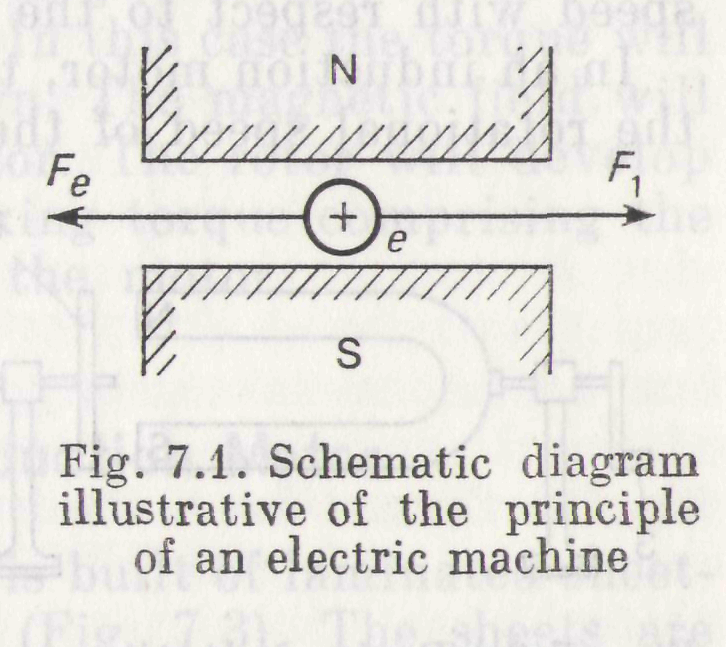
- •6.1. General
- •6.2. Principle of Action and Construction
- •6.3. Transformer Operation
- •6.4. Three-Phase Transformers
- •6.5. Open-Circuit and Short-Circuit Tests
- •6.6. Service Properties Defined from Tests
- •6.7. Autotransformers
- •6.8. Instrument Transformers
- •7.1. General
- •7.2. Induction Motor Action
- •7.3. Construction Features of an Induction Motor
- •7.4. Running Conditions of an Induction Motor
- •7.5. Torque Produced in an Induction Motor
- •7.6. Induction Motor Performance
- •7.7. Starting an Induction Motor
- •7.8. Motors with Improved Starting Characteristics
- •7.9. Speed Control of Three-Phase Induction Motors
- •7.10. Single-Phase Induction Motors
- •7.11. Synchronous Generator Principle and Construction Features
- •7.12. Synchronous Generator Performance
- •8.1. Dc Generator Operation Principle and Construction
- •8.2. Armature Windings and emf
- •8.4. Commutation
- •8.5. Operation of the dc Machine as a Generator
- •8.6 Dc Generator Characteristics
- •8.7. Operation of the dc Machine as a Motor
- •8.8. Starting dc Motors
- •8.9. Dc Motor Characteristic Curves and Speed Regulation
- •8.10. Losses and Efficiencies
- •8.11. Universal Commutator Motors
7.1. General
Electric machines find extensive application today in every branch of industry. They convert energy from mechanical to electrical form and from electrical to mechanical form. The machine converting energy from mechanical to electrical form is known as a generator and that converting from electrical to mechanical form is known as a motor.
The conversion process is essentially reversible, hence a generator can be made to act as a motor and a motor as a generator. An electric machine can also function as a frequency converter, phase converter, dc converter, etc.
Depending on the kind of current they generate or utilize, electric machines fall into two large classes, alternating-current (ac) machines and direct-current (dc) machines. AC machines can be of the single-phase and polyphase types. Of these, the widest uses are made of three-phase synchronous and induction machines and also commutator machines which allow for the efficient adjustment of the rotational speed over a wide range.
F or
its operation, an electric machine depends on electromagnetic
induction and electromagnetic forces. Fig. 7.1 illustrates the
principle of operation of an electric machine. If we place a
conductor in the magnetic field between the poles of a permanent
magnet or an electromagnet and enable it to move under the action of
forceF1
perpendicular to the magnet lines, an
emf will be set up in the conductor, which is equal to E
= Blv, where В
is the magnetic flux density, l
is the length of the conductor cutting
the magnetic lines, and v is
the speed with which the conductor travels
in the magnetic field. The emf
generated in the conductor is shown to be in the
direction away from the observer,
according to the right-hand rule.
or
its operation, an electric machine depends on electromagnetic
induction and electromagnetic forces. Fig. 7.1 illustrates the
principle of operation of an electric machine. If we place a
conductor in the magnetic field between the poles of a permanent
magnet or an electromagnet and enable it to move under the action of
forceF1
perpendicular to the magnet lines, an
emf will be set up in the conductor, which is equal to E
= Blv, where В
is the magnetic flux density, l
is the length of the conductor cutting
the magnetic lines, and v is
the speed with which the conductor travels
in the magnetic field. The emf
generated in the conductor is shown to be in the
direction away from the observer,
according to the right-hand rule.
If we now connect the conductor to a load, the mf will force the current to flow in the closed loop in the direction of the emf. The current interacting with the magnetic field between the poles produces an electromagnetic force Fe which, according to the left-hand rule, is in the direction opposite to that of the force F1 moving the conductor in the field. When F1 = Fe, the conductor will travel at a constant speed. Consequently, this simplified electric machine converts the mechanical energy expended on the conductor movement to the electric energy delivered to an external resistive load and, hence, operates as a generator. This same machine can be made to run as a motor. If we connect the conductor to an external source of emf, the current flowing through the conductor produces an electromagnetic force. Fe which tends to move the conductor in the field as it overcomes the opposing force of a mechanical load.
To increase the emf and electromechanical forces, electric machines are built up with windings that consist of a large number of conductors interconnected so that their emfs become additive, i.e. have the same direction. An emf is possible to induce in a stationary conductor by moving the field with respect to it.
